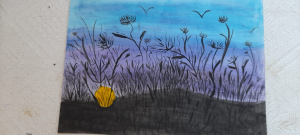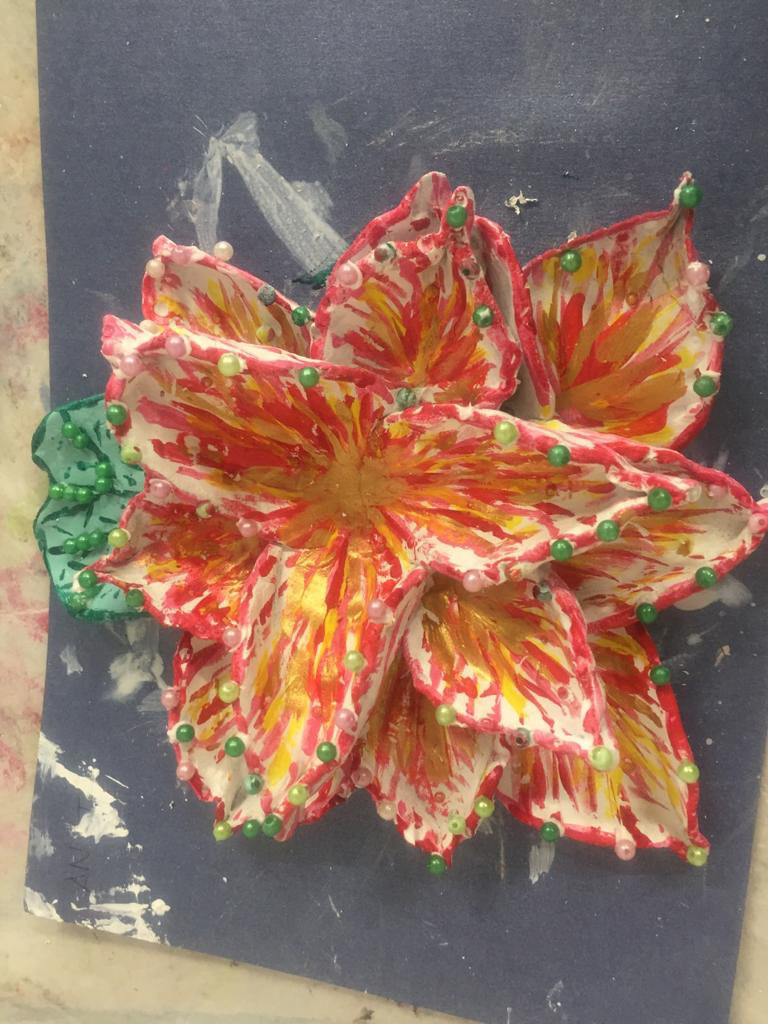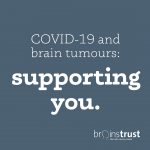We spoke to Anita about how she has used creativity as a tool to help her move forward following her brain surgery.
In 2018, Anita had two operations to remove two meningioma brain tumours. Like for so many others, her diagnosis came as a huge shock. She was 52, happily married with three teenage children and her beloved cat! Following these two surgeries, and learning to live with fatigue and the other consequences of her diagnosis, Anita is embracing her new reality through an emphasis on her well-being, and exploring creativity.
As she puts it, she is ‘Coming to terms with her new world as if a child – marvelling at its beauty’.
Below, Anita has shared some information about her artistic and creative journey and how this is helping her to improve her well-being and self-esteem:
I have a mission to connect old neural pathways and develop new synapses from new experiences within my accepted comfort zone. To develop my self-esteem and feeling of self-attainment. To laugh and smile at the silliest things!
Apprehension
I made a mistake. I’ve been focusing on my brain but really the true recovery is going to come from the mind! The distinction I make between the two is that the brain consists of the physical matter, which I leave up to the doctors to take care of (they do an amazing job!) but in reality there are no absolute answers to the questions I have. The mind is responsible for things like my imagination, creativity and subconscious which is up to me to develop in order to cultivate my happiness.
Resistance

What am I afraid of? Coming out of my comfort zone? I live in my own self-built cocoon… but I have been told the grass is greener on the other side.
It feels like I have been asked to complete a 100-metre hurdle race, but I’ve never jumped a hurdle! We can live in an illusion of such disbelief, especially in the pandemic, about what we can do?
My immediate response is resistance, step away as it’s all new and I don’t have the skills…
My discovery
Creative tasks have taught me to accept my apprehensions and shown me with small steps that I can discover something new and hidden in my inner self…
Accessing the right side of my brain, combining soul and consciousness with intellectual creativity to deliver an intrinsic compassionate response.
It’s a leap of faith as with each brush stroke or sentence I don’t know what is going to come out as I unlock different doors in my mind…
I concentrate my efforts with all I can muster at the time by practicing divergent thinking methods (as opposed to convergent thinking). I’m learning to not overanalyse every task – get real and focus on the task at hand. Breathe the moment, take it in steps and learn as I try.
Creativity has given me a sense of purpose in my otherwise muddled, confused mind. It’s delightful, beguiling and surprising, especially as it’s all novel to me.
My methods and what I found
- Dry clay modelling
- Water colour paintings
- Decorating cakes (Christmas cake)
- Painted glass jar (Diwali)
- Poetry
- Creative writing
- Mindful art therapy
I have begun to recognise that when I am writing, creating or painting something, my mind is somewhat detached. It dissociates with what I’m doing, so I don’t have a total grip on what I’m producing. I consciously feel disconnected so it’s a surprise and a wonder when I produce something. It’s like opening an unexpected present – you just hope for the best!
I’m creating a blueprint of how my mind wishes to explore and express itself. It’s a charming, enchanting delight, a road of discovery, a mental way of massaging and soothing the mind. It’s a live meditative engagement. It acts like a medicine to the body and a fruitful remedy for the mind.
“Art feeds the brain” – May Archer
“Unlock the mystery, put into words what you feel… share your thoughts, ideas, dreams… a picture speaks a thousand words…” Anita Williams (me!)
My situation sometimes makes me feel worthless, but this is work I can do. Nobody can say it’s useless, or that I can’t do it.
I’m communicating to the world that I can do something and I’m open to intrinsic ideas, individual improvement and my hidden awareness. This is my exploration of my mind and brain to see what is there, what I am left with. I welcome a transformation of me and my mind, as opposed to just the physiological brain. And the bonus? By exploring my subconscious I’m showered with feel good endorphins.
Read Anita’s poem ‘Is resistance futile?’ here.
Plough on

When I get stuck, I stand back and re-assess the situation from a different angle. Leave it for a day or two and finally a penny might drop somewhere…
This makes it therapeutic as I mentally massage my brain. I’m connecting old neural pathways as well as reaching out to create new neuronal connectors and my reward? Feeling my endeavours were worth it, as the next time that I am faced with a creative task I have the confidence to give it a shot.
It’s daunting and scary. Can I paint like Monet straight away? Do I really need to answer that? Drop my unrealistic expectations and just give it a shot – it’s an achievement just trying… finding some of my lost self-worth and exploring a selection of my undiscovered talents.
“I create beautiful art so I can look back on the life my body fell short of in such a way that it brings me peace” Nikki Rowe
“Art can permeate the very deepest part of us, where no words exist” Eileen Miller
Try it for yourself
Anita sees countless advantages of embracing creativity:
Getting to share a part of yourself with others, teaching your mind to focus, uncluttering your mind, giving yourself some me time, letting go of the fear of making mistakes are just some of them!
Below, Anita has shared some pointers to help you get the most out of your creative adventure – whether it’s poetry or painting!
- Stretch before you start – try yoga, breathing exercises, or just putting your arms above your head and smiling!
- Play music that relaxes you
- Find a place to create where you feel happy and calm
- Early in the morning can be a good time to be creative, as the mind is less cluttered
- Speaking of clutter! De-clutter your environment so you have an uncluttered mind
- Keep hydrated with water
- Wear comfortable clothing and make sure you are warm
- Make sure other members of the household know that you are working and require peace and quiet to focus!
If you’d like to explore well-being and creativity to help you on your brain tumour journey, join us for all sorts of activities this Brain Tumour Awareness Month.
The Great brainstrust Create-Off is the perfect opportunity to share some of your creativity with the brain tumour community.







